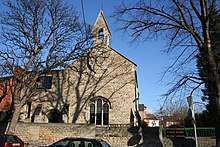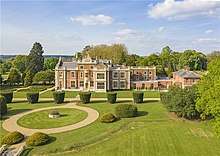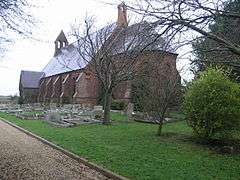Edward Browning
Edward Browning (1816 – 1882) was an English architect working in Stamford.
Edward Browning | |
|---|---|
.jpg) National School, Grantham 1858-9 | |
| Born | 1816 |
| Died | 14 April 1882 Upper Tooting |
| Nationality | English |
| Alma mater | Pupil of George Maddox, |
| Occupation | Architect |
| Practice | In Stamford, first in partnership with his father, after 1856 by himself. |
Life
Edward Browning was the son of the Stamford architect Bryan Browning (1773-1856). He was apprenticed to the London architect George Maddox and by 1847 was in partnership with his father. The partnership continued until his father's death in 1856. Edward Browning qualified as an ARIBA on 22 March 1847. Their architectural practice was at No. 16, Broad Street, Stamford.[1] The Stamford architect Joseph Boothroyd Corby was a pupil of Browning and the architectural practice was continued by J. C. Traylen.
He became Mayor of Stamford in 1862-3.
Works
With his father
- Stamford Bridge
- Conservative Club, Stamford.
- Red Lion Street-High Street
- Midland Bank[2]
By himself
Schools

Little Gonerby, Grantham Primary School, 1863
- Grantham National School 1858-9[3]
- Little Gonerby Primary School, Grantham. (1863). Now Belvoir House Care Home
- Stamford High School[4]
Hospital and almshouses
- Stamford Hospital, three fever wards.[5]
- Market Deeping almshouses[6]
Public buildings
.jpg)
Former Corn Exchange,Broad Street, Stamford
Churches
- Amber Hill, Lincolnshire brick-built church.[9]
- Holme Church, Cambridgeshire.
- Dunton Church, Northamptonshire.
- St Helen's Church, WheathampsteadSt Helen’s Wheathampstead, 1864 [10]
- All Saints' Church, Fosdyke[11][12]
- Snelland Church[13]
Churches Gallery
|
Houses

Barrington Hall, Essex, following restoration 2019.
- Barrington Hall, Essex. Redesigned the facade in Jacobethan style in 1863[14][15]
- Byard House, Stamford
- No 16 Cornmarket, Stamford[16]
.jpg)
Former Boat Inn, 3 St Mary's Hill, Stamford
Shop
- Albert House, 58 High Street, Stamford. An example of Ruskinian Gothic using contrasting coloured stone.
gollark: You can't empty todo lists, you wrong person.
gollark: Wow, *someone* hasn't heard of the Intel Management Engine.
gollark: (memory fragmentation isn't real)
gollark: Wow, this is very ethical code.
gollark: Oh, like the helloboi state machine?
References
- "Colvin" (1995), pg.172.
- ”Antram” (1989), pg. 709.
- ”Antram” (1989), pg. 325.
- ”Antram” (1989), pg. 697.
- ”Antram” (1989), pg. 699.
- ”Antram” (1989), pg. 554.
- ”Antram” (1989), pg. 703.
- ”Antram” (1989), pg. 709.
- ”Antram” (1989), pg. 99.
- Luna http://images.lambethpalacelibrary.org.uk/luna/servlet/detail/LPLIBLPL~34~34~111595~116875:Signed-Edward-Browning,-Architect
- ”Antram” (1989), pg. 283.
- Historic England. "Church of All Saints (1360494)". National Heritage List for England. Retrieved 28 March 2018.
- ”Antram” (1989), pg. 158.
- ”Colvin” 172
- The Architect's Engineers and Building Trades Directory, (1868), 103.
- ”Antram” (1989), pg. 702.
- ”Antram” (1989), pg. 166.
- ”Antram” (1989), pg. 711.
- ”Antram” (1989), pg. 236-7.
- ”Antram” (1989), pg. 715.
- ”Antram” (1989), pg. 166.
- ”Antram” (1989), pg. 695.
- ”Antram” (1989), pg. 173.
- ”Antram” (1989), pg. 713.
Literature
- Antram N (revised), Pevsner, N. & Harris J, (1989), The Buildings of England: Lincolnshire, Yale University Press.
- Antonia Brodie (ed), Directory of British Architects, 1834–1914: 2 Vols, British Architectural Library, Royal Institute of British Architects, 2001, Vol 1, pg. 281.
- Colvin H. A (1995), Biographical Dictionary of British Architects 1600-1840. Yale University Press, 3rd edition London, pg.172.
External Links
| Wikimedia Commons has media related to Edward Browning (architect). |
This article is issued from Wikipedia. The text is licensed under Creative Commons - Attribution - Sharealike. Additional terms may apply for the media files.
.jpg)

.jpg)